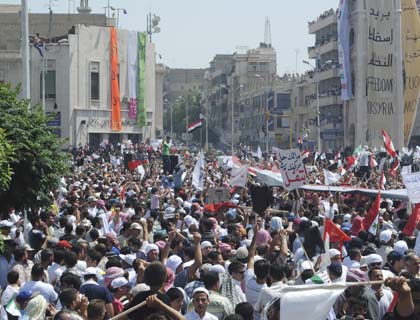Violence hashit the height in Syria as the international community blames the regime forviolence in the country, and Mr. Gen Mod, United Nations peace keeping forcesaid they have come under fire indirectly from close distances. He also saidthat mission has failed and there is increasing civil war in the country.
The deadlinefor UN's monitors in the country would end on June 21, and it is not clearwhether the deadline would be reset or not. His remarks show blunt failure of truce-planbrokered by UN-Arab envoy, Mr. Kofi Annan, the former general secretary toUnited Nations on April 12.
Seemingly, the Arab Spring before it flowered in the Syria has been hardly hit because thecountry is exposed to much more regional rivalry as many countries have large at stack. When the uprising started morethan a year and half ago, it got the global attention. Everybody around theworld was (perhaps, are) feeling sympathy with demonstrators. As well, the timewas ripe and much exposed to change, because the wave of the so-called spring wastough enough to challenge the pillars of all regional authoritarian regimes.The success of demonstrators in Tunisia, Egypt and their superiority inBahrain, Yemen, and Libya all were good source of psychological fuels to setthe Syrian demonstrators on the roller-coaster of opposition to Bashar-al-Assadregime.
Thanks to NATO-led military intervention in Libya which sparked criticisms ofhuman rights activists but remained generally unheard because the outcome ofthe intervention supported the status of anti-Moammar Gaddafi regime parties.
While in thetwo other countries—Yemen and Bahrain—the movements took a different path dueto regional differences. Initially, inBahrain protestors marched to streets to ask for socio-economic and politicalreforms, with no visible bias to particular sect. but unfortunately, theregional arrangement of power that also on the basis of clear sectarian lineturned the movement upside down. Demands got stinky and one sect just retreated and the other put step ahead.
A similarstory was repeated with minor differences as in the case of Yemen tribal bondage was far stronger than religious ties and the demonstrator failed toform an uprising with national characteristic. As a result, civil uprisingreceded with no visible achievements.
So, thefailure of civil unrest in the three above mentioned countries indeed caused Mr.President Bashar al-Assad to a see a glimpse of light at the end of long tunnelof the time. From the very start, the regime responded with clenched fist andbranded them as terrorists. The regime showed no flexibility againstdemonstrators and used all its force to suppress them.
Thesituation became gruesomely dangerous when the international community failedto take a joint front against Damascus. Drafts prepared mostly Europeancountries for tougher action two times were vetoed in the United NationsSecurity Council by China and Russia which feared about the consequences. In other words, after both countries—China and Russia—grudgingly accepted toavoid exercising their veto right in the UNSC in the case of Libya. Theresolution paved the way for foreign military intervention. The mission fromprotecting civilians was changed into outstation of Moammar Gaddafi.
So, in order not to undergo similar situation, Chinese and Russian officials dealtwith Syrian regime with much more caution. They refused to approve drafts whichindirectly paved the way for military intervention.
Moreover,the Libyan mission was not carried completely with visible victory. Itcontinued for months and imposed cost on the already slowing down military budget. So, it is clear that comparing Libya with Syria is a bluntmistake because the regime of President Assad is far powerful and alsointerconnected with countries like Iran and groups like Hezbollah.
Thus,considering the challenges, it is far likely for anti-Assad countries to start a war against Damascus. In other words, the United States is engaged in acorrosive war against Taliban-led militants in Afghanistan and just pulled outof Iraq; clearly, it does not have the will to start another war in such crisisridden region. Without the US, it is far likely that its European allies embarkto such financially and humanitarianly costly war.
The regionalrivalry among countries is also something that cannot be neglected assessingthe ongoing situation in Syria.
Tehran hasbeen supporting President since the very start of civil uprising. The supremeleader who is the ultimate decision maker in the country, Mr. Ayatollah AliKhamenae often openly voiced out support for Damascus regime while condemningother regimes and reacted similarly in the case of uprising breakout. Whileinsisting that Arab countries are affected by more than 30-years old Islamic revolution in Iran, he linked civil unrest in Syria to foreignintervention.
Therefore,the so-called proxy war and the dominant presence of Allawites, a minor who canhardly be branded as part of Shiite group, have further complicated thesituation.
According tothe United Nations reports, around 9000 people are killed since the start ofuprising more than a year ago, and around 800 people killed in period afterceasefire accord mediated by joint Arab-UN's representative, Mr. Kofi Annan. Theceasefire has not helped least to peace and instability. With the presence ofArab monitoring mission, available reports denote on severe clashes betweenminor armed opposition and security forces.
Seemingly,all stakeholders are tittering up and down to find a solution to the deadlockbut there is nothing to count on much. But this is Syrian people who ultimatelyshoulder all the burdens of continuous instability and unrest.

